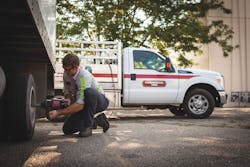Fleets place heavy demands on the tire dealers who serve them. Every move, every conversation, comes down to the same question: Can you save them money?
“When you look at truck tires, they’re a commodity-based business,” says Scott McKenzie, vice president of the commercial division for Indy Tire Centers Inc. “There are a lot of dealers with the same brand. What separates you from your competition is your level of service. All the dealers have the same kinds of services, so it’s your level of service that differentiates you.”
The Indianapolis-based dealer provides varying levels of service for fleets. Some subscribe to the business’ mounted wheel program. Indy Tire Centers provides mounted tires and the fleet replaces and installs them as necessary. Other fleets rely on Indy Tire Centers to “take care of everything.” The fleet manager establishes a tread depth pull point. When the tire dealer’s service technicians perform maintenance checks and find a tire at or below that already-established tread depth, the tire is replaced. No correspondence with the fleet is required. Still other fleets want to do the tire work themselves, but rely on their dealer for information about the technological advances in tires.
Tires are a fleet’s second largest expense, behind fuel. “It’s important we stay on top of our game,” McKenzie says.
Much of what fleets want — and need — depends on how big they are. “Small fleets tend to do stuff more in house because they might have mechanics that have more time.” From McKenzie’s standpoint, small fleets are those with 15 to 20 units, or less. A large fleet includes at least 100 vehicles. Fleets bigger than that are the exception, he says, though one of Indy Tire Centers’ biggest fleets, Ryder System Inc., has been a customer for almost 20 years.
Generally, smaller fleets need the most help identifying things to reduce their cost per mile, McKenzie says, “whether that’s technology in the tires or introducing retreading or a different tread in retreading.
“Make sure they have full manufacturer’s support. If there are wear issues, work with them to see where they’re coming from. Looking at scrap tires and doing analysis, why they’re coming out premature and is there something we can do from a training standpoint? Can we do something with the drivers?
“We have a computer program we run them through that will show them the top seven reasons for coming out of service early. It might be driver error. Maybe the repair or age exceeds fleet specs. If there’s a lot for that, let’s increase your specs. Instead of five years on that casing, let’s do six.”
About 1,800 miles to the west, Commercial Tire Inc. is asking its fleet customers similar questions. Commercial Tire operates 39 locations in Idaho, Oregon, Utah and Washington.
[PAGEBREAK]
George Hammon, the corporate commercial sales manager, says one big change has been how medium-sized fleets are asking to track more specific details. “They want to track different products, Tier 1, Tier 2 and Tier 3 tires.” They’re measuring costs and mileage performance, and “I think they’re looking at all performances,” he says, meaning both tires and vehicles are evaluated on a regular basis.
“We have different tracking as far as performance calculators. The fuel economy is done mostly off the computers in their trucks,” Hammon says.
“A lot of our business comes from agricultural service. Inside the fleet segment there’s a lot of ag fleets,” Hammon says.
“A farm business might have 15 to 25 10-wheeler trucks that operate during harvest and planting time. They might get 15,000 to 30,000 miles a year. Some have 18-wheelers.”
No matter the truck size, Hammon says, “It all comes down to one thing. Cost per mile.” And even though it’s always the priority, it seems more critical when those farmers are begging, and praying for rain. “We’re not at quite the Dust Bowl yet. But our ag business, that drives a lot of our business in the Northwest. If we don’t have water, we’re in desperate trouble.” ■
What do fleets want from you?
Modern Tire Dealer’s sister publication, Heavy Duty Trucking (HDT), tackled the topic of how fleets should best work with their tire dealers. Given the bevy of data fleets already are managing, tracking the miles, usage and wear of a fleet’s tires is enough to drive a fleet manager crazy. “That’s why a good relationship with an outside tire dealer or service provider is vital,” HDT’s Equipment Editor Jim Park wrote.
“Tire maintenance, perhaps one of the least attractive tasks in a fleet’s work roster, is becoming increasingly data driven,” Park said. “Fleet managers now have access to tire information they didn’t have just a few years ago, thanks to tire pressure management systems, telematics, etc., and they are using that information to inform their maintenance and service needs.”
Park outlined the benefits available through dealers who utilize the services offered by the Big Three’s commercial programs, which manage vehicle make, model, horsepower and specific unit number, as well as miles driven, tire brand and model, tire wear, maintenance performed and wheel position.
The data is used in countless ways. Sometimes it provides a big picture look at how much fleets are spending, how many miles they’re driving and a general guide on how to budget for tires. Other times, it’s a tool to drill down and determine that a certain tire isn’t performing well, or that there’s a better option with more retreads available for better long-term savings.
On top of that, tires play a big role in the Federal Motor Carrier Administration’s Compliance Safety Accountability program.
As a result, Park wrote, “You can no longer afford to let your guard down on basic tire inspections.”
His final question for fleet managers is an obvious opportunity for tire dealers to move in and provide support.
“Do your technicians really have the time and expertise for all that on top of their other responsibilities? It might be time to call in somebody who can make it all happen.”
About the Author
Joy Kopcha
Managing Editor
Joy Kopcha joined Modern Tire Dealer and Auto Service Professional as senior editor in 2014 after working as a newspaper reporter for a dozen years in Kansas, Indiana and Pennsylvania. She was named managing editor of MTD and ASP in 2022, and took on that same role with Motor Age in 2024.
She is an award-winning journalist, including in 2023 when she was named a Jesse H. Neal Awards Finalist.
Don't miss any of her articles. Sign up for MTD's newsletters.

